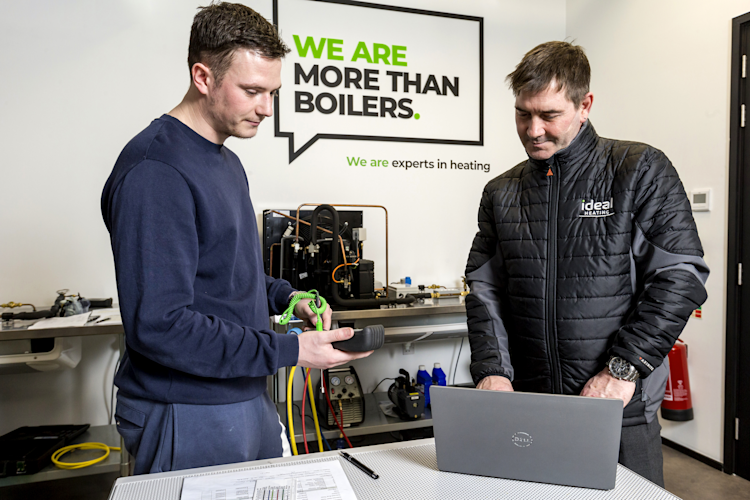
How to choose an eco friendly boiler
Boiler manufacturers have made huge strides in recent decades when it comes to designing more environmentally friendly models. Since April 2015 it has been the law in the UK that every new gas boiler installation must be a more eco friendly and efficient condensing boiler — a huge change in the industry.
If you’re conscious of reducing your carbon footprint, it’s something you can achieve by thinking about your central heating set-up. In this blog, we’ll look at some of the key factors to think about when it comes to finding a more eco friendly boiler, including how efficiently they operate, as well as exploring alternatives to gas boilers.
Finding an eco friendly gas boiler
Every new boiler on the market is a condensing boiler, which will be A-rated on the scale created by the ErP (Energy-related Products Directive). This means they scored between 92% and 94% in terms of energy efficiency — the more efficient your boiler is, the less impact it will have on the environment and the less it costs to run.
How do condensing boilers heat our homes efficiently?
Condensing boilers heat our homes and provide us with hot water by burning fuels just like non-condensing models. The way they achieve such impressive efficiency results is by recovering heat from ‘waste’ gases that would otherwise be lost.
The energy that condensing boilers recover from these gases can be used to keep the water in central heating systems warm as it returns to the boiler from the radiator — this means less energy is required to restart the process of reheating the water.
Boilers endorsed by the Energy Saving Trust
For extra peace of mind that your boiler offers a more eco-friendly central heating solution, look out for boilers that are endorsed by the Energy Saving Trust.
At Ideal Heating, we’re proud that several of our boilers have this endorsement, including the Mexico HE Heat only boiler and the Logic MAX Combi combination boiler.
What are the alternatives to gas boilers?
Advances in technology are making gas boilers more and more efficient, but in the near future we will see an increased focus on alternative heating systems. Beginning in 2025, all New Build homes will use low-carbon heating systems such as heat pumps and heat networks.
So, how do these new alternatives to gas boilers work and what makes them so efficient and eco friendly?
What are heat pumps and how do they work?
Heat pumps are expected to play a key role in delivering heat to our homes in the future. These alternative central heating solutions extract heat from three sources — the air, the ground or a body of water — and use it to provide hot water and heating to our homes.
This heat is absorbed from these sources into a liquid that’s circulated through a system of pipes. All heat pumps use a compressor to greatly increase the temperature of this fluid, which it achieves by increasing its pressure.
When this heat is transferred to our homes, it provides the warmth we need for our radiators, hot water and other domestic heating.
How heat pumps reduce carbon emissions
By drawing on naturally occurring heat from the ground, air and water, heat pumps are able to use much less carbon to heat our homes than traditional boilers.
The compressor is often the only element of these systems that draws on the traditional power grid. As they use less electricity to provide heat than boilers, heat pumps can reduce your energy bills too.
Deciding which heat pump will work best for our homes depends on where the property is located and what sources of heat might be available nearby.
How do air source heat pumps work?
These are often located outside and extract heat from the air into a liquid, even working when temperatures outside are lower. A compressor then increases the liquid’s temperature, which in turn is used to heat the domestic hot water and central heating.
There are two main types of air source heat pumps:
Air-to-water heat pumps can power both your hot water and your central heating, just like a gas Combi boiler does. They use a conventional wet (or water-based) system to provide heat to radiators.
Air-to-air heat pumps use a network of fans to provide homes with central heating, but they cannot provide hot water. These fans can also be used to help cool homes during the Summer months.
How do ground source heat pumps work?
These heat pumps use pipes buried outside to extract heat from the ground, which it uses as an alternative to traditional fuels. This heat is transferred to a liquid that circulates through the pipes, before a compressor raises the temperature of the liquid. The heat this creates is then used to provide hot water and domestic central heating.
How do water source heat pumps work?
These heat pumps are an option if your property is close to a river, lake or small stream. A series of pipes are submerged in the body of water and fluid is pumped through the system, absorbing heat from the water. Once a compressor is used to increase the temperature of the fluid, this heat can be transferred to provide hot water and heating for homes.
Heat networks
Heat networks are another alternative to gas boilers, sometimes known as ‘district heating’. These are distribution systems that deliver heat from a centralised source to several nearby buildings, which could be homes or commercial premises.
The UK Government believes these networks could play an important part in reducing carbon emissions, identifying them as an efficient and cost-effective method of central heating. The more heat networks grow and connect with each other, the more their potential to reduce the use of carbon increases — particularly in built-up areas such as cities.
While gas condensing boilers provide an affordable and reliable solution to millions, at Ideal Heating we are working hard on our next generation of products.
We aim to not only help deliver reduced carbon emissions, but to do so in a way that affords the least disruption as possible to UK home owners, businesses and installers.
You’ll find further advice on central heating, servicing and boiler care in our FAQs, as well as more in-depth guides on the Ideal Heating blog.


















